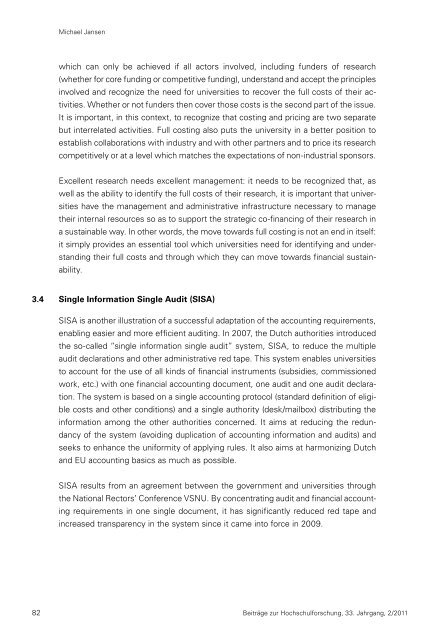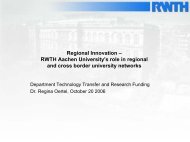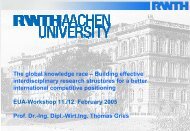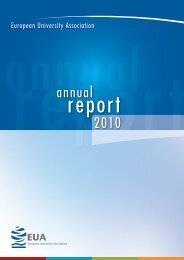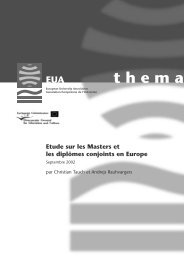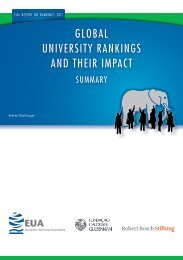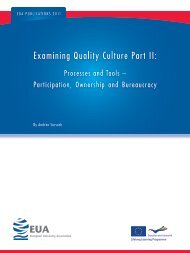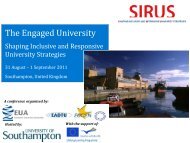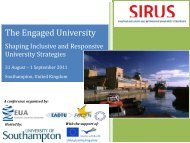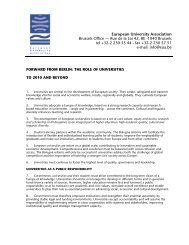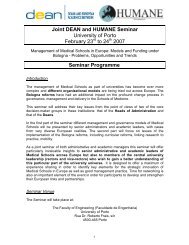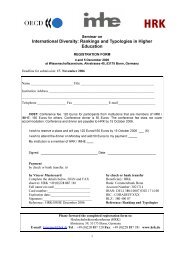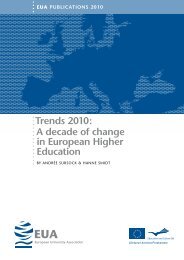Beiträge zur Hochschulforschung - European University Association
Beiträge zur Hochschulforschung - European University Association
Beiträge zur Hochschulforschung - European University Association
You also want an ePaper? Increase the reach of your titles
YUMPU automatically turns print PDFs into web optimized ePapers that Google loves.
82<br />
Michael Jansen<br />
which can only be achieved if all actors involved, including funders of research<br />
(whether for core funding or competitive funding), understand and accept the principles<br />
involved and recognize the need for universities to recover the full costs of their ac-<br />
tivities. Whether or not funders then cover those costs is the second part of the issue.<br />
It is important, in this context, to recognize that costing and pricing are two separate<br />
but interrelated activities. Full costing also puts the university in a better position to<br />
establish collaborations with industry and with other partners and to price its research<br />
competitively or at a level which matches the expectations of non-industrial sponsors.<br />
Excellent research needs excellent management: it needs to be recognized that, as<br />
well as the ability to identify the full costs of their research, it is important that univer-<br />
sities have the management and administrative infrastructure necessary to manage<br />
their internal resources so as to support the strategic co-financing of their research in<br />
a sustainable way. In other words, the move towards full costing is not an end in itself:<br />
it simply provides an essential tool which universities need for identifying and under-<br />
standing their full costs and through which they can move towards financial sustain-<br />
ability.<br />
3.4 Single Information Single Audit (SISA)<br />
SISA is another illustration of a successful adaptation of the accounting requirements,<br />
enabling easier and more efficient auditing. In 2007, the Dutch authorities introduced<br />
the so-called “single information single audit” system, SISA, to reduce the multiple<br />
audit declarations and other administrative red tape. This system enables universities<br />
to account for the use of all kinds of financial instruments (subsidies, commissioned<br />
work, etc.) with one financial accounting document, one audit and one audit declara-<br />
tion. The system is based on a single accounting protocol (standard definition of eligi-<br />
ble costs and other conditions) and a single authority (desk/mailbox) distributing the<br />
information among the other authorities concerned. It aims at reducing the redun-<br />
dancy of the system (avoiding duplication of accounting information and audits) and<br />
seeks to enhance the uniformity of applying rules. It also aims at harmonizing Dutch<br />
and EU accounting basics as much as possible.<br />
SISA results from an agreement between the government and universities through<br />
the National Rectors’ Conference VSNU. By concentrating audit and financial account-<br />
ing requirements in one single document, it has significantly reduced red tape and<br />
increased transparency in the system since it came into force in 2009.<br />
<strong>Beiträge</strong> <strong>zur</strong> <strong>Hochschulforschung</strong>, 33. Jahrgang, 2/2011


